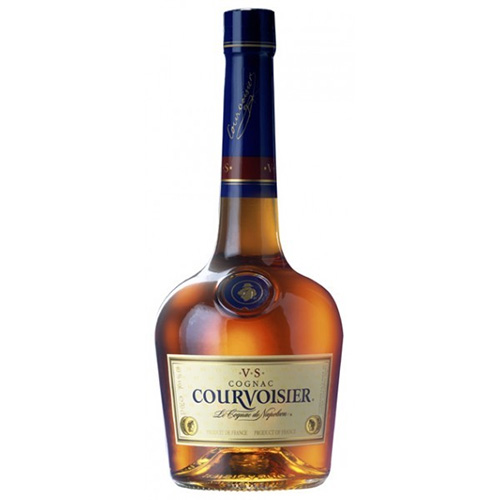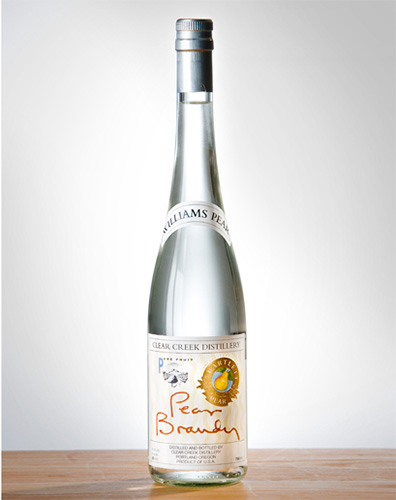Even in today’s more cocktail-centric world, in which quality ingredients and careful preparation are celebrated, and liquor is enjoying a wave of popularity and respect that it hasn’t seen since perhaps the days before Prohibition, even the best brandy still suffers from a bit of a stuffy reputation.
No more, I say! Forget that image of an older gentleman in a robe, nestled into his arm chair in front of a roaring fire, swirling a gigantic snifter of amber liquid in his hand and taking from it the occasional sip. Brandy can be much more than that. Like whiskey or gin, Brandy comes in many varieties, each with its own subtle nuances. It can be bold and bright, subtle and warming, high proof or toned down. It can be mixed with or taken neat, and is just as happy serving as a modifier in a cocktail as taking center stage. In short, it’s a versatile, delicious liquor worthy of celebration and a place of honor in your liquor cabinet.
Great … But What Is Brandy?
Brandy is the distilled alcohol extracted from any fruit-based mash. A good deal of the world’s brandy is made from grapes and, indeed, the word “brandy” derives from the Middle Dutch “Brantwijn” or “Burned [i.e.: distilled] Wine.” Wine-based brandies come in two types: regular and “pomace,” the latter of which is distilled from the skins and peels of grapes, in addition to just the juice. This gives a different, earthier flavor to the finished product. Examples of this type include Italian grappa and South American pisco. It’s also possible to make brandies from fruits like apples, pears, cherries, and more. These fruit brandies are often called eaux-de-vie, which is French for waters of life.
Many wine-based brandies are, like whiskey, aged in oak barrels for some period of time. This gives the liquor its amber color and notes of spice, caramel, and dried fruit. Like whiskies, the aging process also increases the price. Fortunately, there are inexpensive brandies out there that are very good, and we’ll be covering a few. Brandies made from other fruits are sometimes aged (the French apple Brandy Calvados, for example) and sometimes not (some pisco, most eaux-de-vie).
Types of Brandies
While brandy is a catch-all descriptor for this type of alcohol, there are many specific types worth mentioning. The two best-known types of brandy in the world are probably Cognac and Armagnac, both from France. These two brandies can only be produced in their respective regions, from specific grape varietals. Fine cognacs can run in the thousands of dollars for a bottle, and that’s not even getting into vintages that were distilled before the introduction of American phylloxera mites to European grape stocks utterly decimated the brandy-making world in the 1860s. Yes, you can still buy brandy from before that era … if you have ten grand or more to spend on a single bottle of booze.
Beyond the two French styles, though, there is a whole world of brandy on offer. We’re going to cover as many as we can here. As always, feel free to chime in down in the comments with further suggestions!
Cognac
Here we have the grande dame of brandies, against which all others are measured. Cognac is both a type of brandy and the region in France that produces it. It’s an aged, grape-based brandy that usually comes with a tremendous depth of flavor. Younger cognacs often present light fruit and oak notes, with older ones blooming into lots of dried fruit and spice. Cognac is usually bottled at 80 proof (40% ABV).
By law, you can’t make cognac outside of Cognac, and even inside Cognac you must use specific grapes, and follow specific aging restrictions. Most cognac contains a blend of brandies, and is labeled according to the period of time the youngest brandy of the bunch has spent aging in oak casks. In general the average age of the blend is much older than that of the youngest brandy, with many XOs easily reaching an average age of twenty years.
The labeling scheme is:
Very Special/Superior (VS) – Aged for at least two years.
Very Special/Superior Old Pale (VSOP) – Aged for at least four years.
Extra Old (XO) – Aged for at least six years. According to Wikipedia, citing the Bureau National Interprofessionnel du Cognac, this will be raised to ten years in 2016.
Cognac Brands to Try: Courvoisier, Hennessy, Remy Martin, Hine, Camus, Martell
Suggested Cocktail: Cognac will work beautifully in any brandy-based cocktail, but it’s especially at home in one of the most venerable of the bunch, the Old-School Sazerac.
Armagnac
A little harder to find than cognac, armagnac is nonetheless available at most quality liquor stores. Like Cognac, it’s named after the region of France which produces it, and only brandies made there can legally be called armagnacs. Fruitier than its cousin early on due to a different distilling process, Armagnac transitions into caramel and toffee notes as it ages and takes on more character from the wood. Armagnac is usually bottled at 92-96 proof (46-48% ABV).
Also Like cognac, armagnac must adhere to certain labeling requirements, with the classification built on the age of the youngest brandy in the blend. Armagnacs designated by the year of their bottling are common, and you can find many a liquor store in France with a wide selection reaching back fifty years or more.
The labeling system for armagnac is:
VS – Aged for at least two years.
VSOP – Aged for at least five years.
XO – Aged for at least six years.
Hors d'âge – This roughly translates to “beyond age” and is aged for at least ten years.
Armagnac Brands to Try: Castarède, Cerbois Bas, Sempe, Delord
Suggested Cocktail: Armagnac pairs incredibly well with the Benedictine and Dry Vermouth found in a classic Vieux Carré.
American Brandy
American brandy, like American wine, suffered from a bad rap for a long time. Well past the time, in fact, when it had actually gotten good. No more: people know now that you can get some amazing wines from California, Oregon, and other parts of the US … and some of those wines are being distilled and aged in oak, just like their French cousins. The flavor profile of American brandy is usually similar to that of cognac, though because the Americans are free to use a wider variety of grapes, there is a broad range of possibilities.
Like Cognac, American brandies often use the VS, VSOP, and XO classifications to denote the age and quality of the liquor within, although unlike Cognac and Armagnac, those designations are not legally enforced. Because American brandies are, shall we say, not always quite so refined as their French cousins, I recommend VSOP or better. The good news: American brandy is often a fraction of the price of Cognac or Armagnac. In fact, finding any other oak-aged liquor at these prices, whiskey or brandy or otherwise, is almost impossible. E&J XO, for example, is a terrific brandy that’s on par with many VSOP Cognacs, can be had for about $15 at many liquor stores.
American Brandy Brands to Try: E&J, Paul Masson, Christian Brothers, Korbel
Suggested Cocktail: You’ll be hard-pressed to find a better brandy-based cocktail than The Sidecar.
Brandy de Jerez
Spanish brandy, like Spanish wine (both normal and fortified) is often overlooked. You just don’t hear as much about Brandy de Jerez as you do about French and American brandies. That’s too bad, because the Spanish brandy-making tradition is robust and produces some unique entries, many with subtle flavors of nuts and dried fruit. You may have heard of Jerez before – it’s the region of Spain responsible for giving sherry, a fortified wine similar to port, its name. Brandy de Jerez is made using many of the same grapes and techniques that produce sherry, including the Solera technique, in which older liquids are blended continuously with newer batches to create the final product.
Like other brandies, Brandy de Jerez has a classification system. Solera has an average age of one year and is light and fruity. Solera Reserva has an average age of three years and displays more oak characteristics. Solera Gran Reserva has an average age of ten years and brings lots of dried fruits, roasted nuts, and other notes traditional in liquors long-aged in oak.
Brandy de Jerez Brands to Try: Lustau, González Byass, Magno
Suggested Cocktail: The Between the Sheets, while often made with other brandies, works very well with Brandy de Jerez. The aged rum will really help bring out the brandy’s flavor.
Calvados
Calvados is a delicious French brandy distilled from fresh apples. It has a significant apple scent, but in flavor is delicate, with apple notes that combine very well with the traditional wood and caramel flavors that come from oak aging. It’s produced in the lower part of the Normandy region, in the north of the country, and its production dates back at least to the mid-sixteenth century. To qualify as Calvados, rather than eau-de-vie, the distillate must be aged in oak for a minimum of two years.
Much like seemingly everything else in France, there are many laws dictating exactly how Calvados can be labeled. In addition to certain location designations, Calvados uses age indicators similar to Cognac and Armagnac. The age on the bottle always refers to the youngest brandy in the blend, and is labeled as follows – two years: Fine, Trois étoiles, 3 Star, or Trois Pommes. Three years: Vieux or Reserve. Four years: VO, VSOP, or Vielle Réserve. Six or more years: Extra, XO, Napoléon, Hors d’Age, or Age Inconnu.
Calvados Brands to Try: Daron, Busnel, Chateau Du Breuil, Boulard
Suggested Cocktail: The Widow’s Kiss is a big, rich, decadent cocktail made with Calvados. We recommend it with fervor.
Applejack / Apple Brandy
This is Calvados’s wild, unrefined, American cousin. Originally made by repeatedly freezing hard apple cider and skimming the ice from the top, thus slowly increasing the alcohol content, it’s now most typically distilled and stored in the same manner as Calvados. Generally speaking, apple brandies (and applejack in particular) have a heartier apple flavor than French entries, and are a little rougher around the edges, owing in part to the fact that there’s no clear-cut grading system established.
Don’t let that frighten you, though. Applejack is inexpensive and delicious, and many American apple brandies are just as fine as Calvados.
Applejack Brands to Try: Laird’s, Clear Creek, Orchard Hill
Suggested Cocktail: The Jack Rose is a classic Applejack cocktail with a nice blend of sweet and sour that really works with the base liquor’s apple flavor.
Pisco
Pisco is a South American pomace brandy made in Chile and Peru that is often clear and occasionally light yellow. As many varieties of grape can be used in its production, and as the two countries that produce it have very different methods of doing so, Pisco has a wide range of flavors, though the majority of them have a fresh grape scent at the forefront.
Peruvian pisco is aged for as little as three months in chemically inert vessels (i.e.: glass, metal, etc), and thus has none of the flavors associated with oak aging. It cannot contain additives of any kind. It is bottled at distillation strength, without dilution. At its base, Peruvian Pisco resembles strong, slightly grape-scented vodka. However, some methods of creation are specifically designed to retain more flavors from the fermenting grape mash, giving the alcohol much more character.
Chilean pisco is aged in oak and can be diluted to various strengths before bottling. At the lower end of the spectrum, Chilean pisco resembles low-strength white rum, but the older and higher-alcohol variants have a great deal of flavor. The longer it’s aged, the more wood flavors it picks up, with long-aged variants coming to resemble French and American brandies, albeit with a much stronger grape flavor due to the use of grape must in the distillation.
Pisco Brands to Try: Pisco Portón, Macchu Pisco, Control C, Capel
Suggested Cocktail: The Pisco Sour is the most classic pisco cocktail you’re going to find, and the unique use of bitters makes it an interesting variant on the standard sour.
Eaux-de-Vie
If you start with fruit as a base, distill it, and bottle the result without aging it in wood for any extended period, you’ve got eaux-de-vie. These typically clear (but sometimes colored) liquors resemble vodka with subtle fruit notes, and are often served chilled in small glasses as digestifs. Common fruits used in making eaux-de-vie include pears, apples, plums, and peaches, but other fruits may also show up.
In Germany, this type of liquor is called Schnaps, but don’t confuse that with the syrupy-sweet, heavily-flavored stuff that gets labeled “Schnapps” in America. They’re effectively unrelated. German Schnaps, like all other Eaux-de-Vie, are sugarless, high-proof liquors like the rest of the brandies on this list.
Eaux-de-Vie Brands to Try: Clear Creek, Harvest Spirits, and dozens of European brands.
Suggested Cocktail: Believe it or not, there really aren’t any classic Eau de Vie cocktails out there. I recommend giving the Poire Bomb, created by Dan Chadwick, a shot:
- 2 oz. Pear Eau de Vie
- .5 oz. Maraschino
- .5 oz. Ginger Liqueur
- .5 oz. Lemon Juice
- 1 Dash Peychaud’s Bitters
Combine all ingredients in a cocktail shaker over ice and shake thoroughly. Strain into a chilled cocktail coupe. Garnish with a pear slice.

























